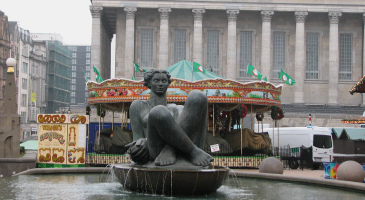
Birmingham has shown a strong commitment to public sculpture in recent years, and though somewhat off-topic for this website, with its mostly Victorian and Edwardian sculpture concerns, an exception can be made for the modern figure sculpture in Victoria Square, and not far off at the end of Corporation Street. The Victoria Square remodelling at the beginning of the 1990s was surely one of the most convincing plans for a city square in recent years. The sculptural centerpiece of the Square is the group of works by Dhruva Mistry. The largest work is called The River, a reclining nude in the central fountain to the Square.
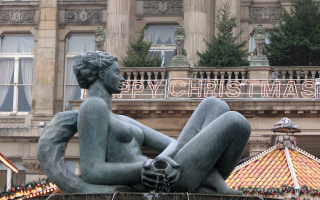 The River, sculpture by Dhruva Mistry, 1993.
The River, sculpture by Dhruva Mistry, 1993.
She gazes straight ahead, and is posed leaning on one elbow, the other arm stretched across her so that her two hands clasp a small vessel (small on the scale of this large monument, at least), from which water pours into the fountain. Her legs are crossed and somewhat raised, so that overall, the figure stretches only about twice as long as she is high, and has something of a balance between the upper torso and head, and the mass of the legs. An indeterminate semicircle of bronze, indicative of drapery, perhaps, loops out behind her shoulder and round under her arm. The treatment is somewhat stylized; though the proportions are correct, and the legs fairly naturalistic, the solidity of the arms, the lack of musculature, the columnar neck, all emphasise mass and solidity. The staring face, vaguely Indian in physiognomy, is carefully modeled but deliberately symmetrical, and there is some hearkening back to Eastern archetypes here, though the thick neck would not be found on a piece of historic Indian sculpture. The treatment of the hair is without detail, and there is no interest by the sculptor in naturalistic drapery.
Views of Mistry's group entitled 'Youth'.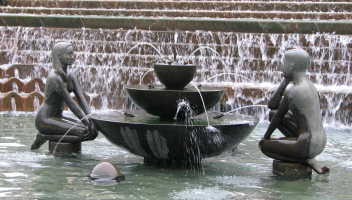
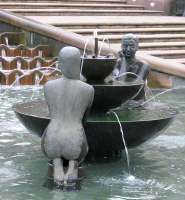
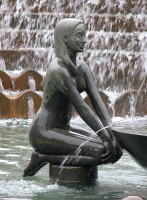
In the lower pool is a group, also by Mistry, entitled Youth, consisting of two kneeling nude figures, male and female, looking at each other across a three-tiered fountain. There is certainly a similarity of style, though here the figures are slender. The girl kneels down, arms stretched forward to hold her knees, with something of a structure to the arms but less to the legs, which are almost tubular, more naturalism to the treatment of the stomach, breasts and back, and a rather similar face to the larger work, though no delineation of the hair at all. The male figure, a youth, has one knee down, the other up, so that he can lean his elbow upon it, with his hand against his face; the other arm is outstretched as with the girl.
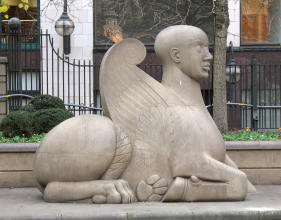
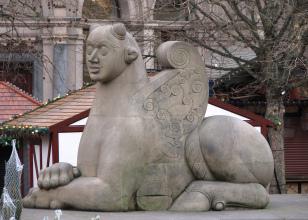 The Guardians, by Mistry, also in Victoria Square.
The Guardians, by Mistry, also in Victoria Square.
The other figural pieces by Mistry are a pair of enormous beasts, somewhat sphinxlike, but perhaps more akin to the Abyssinian figures in the British Museum. They are of stone, and entitled The Guardians. Each has a relatively small human head. One is more female, though without hair and with odd protrusions in the position of ears and horns; stylized up-curving wings, the front paws of a lion, and the rear legs of a bull. It is these paws and hooved rear legs which are the best feature, being expressive of great mass and weight. The more male figure, again hairless but with ears and no horns, also winged, and again with lion’s legs and bull’s legs, but reversed, so that the hooves are in front, the lion’s paws behind.
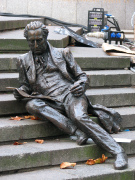 Thomas Attwood statue, by Sioban Coppinger and Fiona Peever.
Thomas Attwood statue, by Sioban Coppinger and Fiona Peever.
The Gormley statue is not for these pages, but mention should be made of the statue of Thomas Attwood, also emplaced in the early 1990s, on the steps in Chamberlain Square. The sculptors were Sioban Coppinger and Fiona Peever, and the piece has a modern treatment concentrating on face and hands, with rather sketchy drapery, and in a wholly informal pose showing the economist seated on the steps, as if caught up in his writing on the parchment he holds.
Robert J. Thomas's reclining statue of Hebe, Corporation Street.
Some dozen minutes walk away, down New Street and then along Corporation Street, past bland buildings at the near end, then two key terra cotta ones – the Law Courts on the left, and Central Hall with its spire on the right – the street then opens up into a pedestrian area with another modern fountain and another nude female statue. This, like the Thomas Attwood statue, is without a base, reclining informally by the water. Her pose is excellent – she lies half sideways, with torso twisted so that her upper body faces downwards, resting on one elbow, the other arm and hand stretched towards the water. She is a finely modelled, slender girl, capturing well the mix of rounded forms, musclulature, and hard boniness. She gazes straight forward, thus partially downwards, rather than towards her hand as it approaches the water, from which we can presume she is in arrested motion, her thoughts elsewhere. The sculptor is Robert J. Thomas, and the statue, which dates from the end of the 1950s or early 1960s, is entitled Hebe.
Hebe, a daughter of Zeus, was the Greek goddess of youthfulness. There are various statues of her dotted around, most notably that by Canova, at Chatsworth and in the Victoria Art Gallery, Bath (3rd statue from left, below). As we would expect, statues of Hebe generally show her youthful, healthy, most usually nude, but sometimes semi-clad in Classical robes, often holding a water pitcher or bowl, and from time to time, as in this modern Birmingham example, associated with fountains. A few examples are below: that on the far right is by William Calder Marshall.
Various 19th Century Statues of Hebe.
Birmingham pages // Corporation and Victoria Square, Victorian sculpture // Colmore Row
Sculpture in England // Sculpture pages
Visits to this page from 6 Apr 2014: 1,340 since 6 October 2024